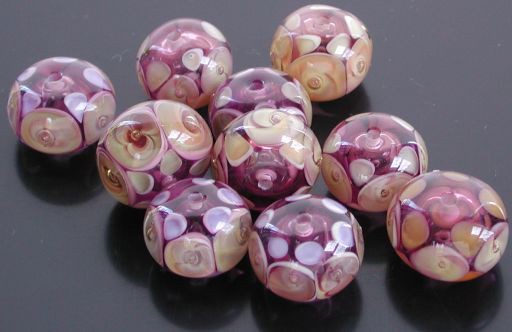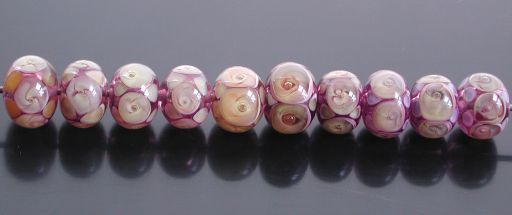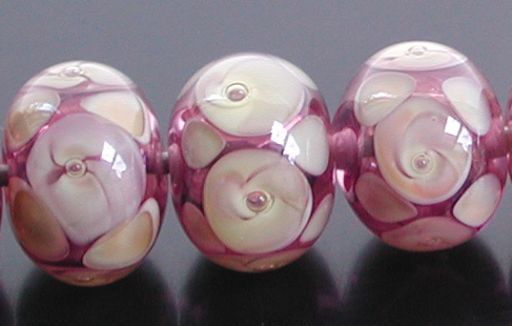I had several goals in making these beads. One was to meet the parameters of the exchange, which specified pastel florals in a bracelet sized bead. As exchange co-ordinator, I suggested yellow and violet for those wanting a more specific color range, just because so many early spring flowers are indeed yellow, purple or white—think about it: snowdrops, winter aconite, narcissi, crocus, grape hyacinth.
Some of the people were comfortable with dot techniques, but not florals, so I did a demo on dot-based florals. I myself happen to be particularly fond of Kristina Logan's approach, a three dot twist positioned inside a larger dot, which I chose for my beads because a) I like them b) I'm lousy at them and c) exchanges are generally considered to be learning opportunities and non-commercial, and therefore copying, a topic on which my views are admittedly quite a bit more liberal than average, would be less controversial.

10 of the 13 beads I made for the exchange. (Two broke, one was mislaid during the photographic session.)
And, since I had to make a bunch, I could get some serious practice in.
Casual examination of the real thing suggests (for example) a bead made with 064 dark transparent purple (i.e. black) on which the artist puts medium opaque cobalt dots of medium size. She then spot cases with white, adding small white dots as fillers; and then, as say for the blue version(s) puts down triplets of opaque medium cobalt blue dots, spot casing these consecutively with opaque white and (I'm guessing) dark aquamarine. Then comes comes the plunging and twisting step, followed by a final spot case over the large dots with a lighter aquamarine, and a either transparent orange, emerald green or pale blue of the spacer dots. All in all, the center of a floral dot is six layers deep.
Ms. Logan makes her base bead with a careful application of lapping cylinders, a technique she says she developed to cope with fragile bead release (presentation, Gathering 2003), and which she also uses to stunning effect on her plain dot-beads which are actually cased.
I'm much too lazy and impatient to emply this technique, so I just swot out a little hollow instead. On a good day (of which there have lately been very few) the walls are of relatively even thickness. For these beads I used a 046 pale transparent amethyst; this proved to be just about the only thing I did consistantly.
Thus the pattern for the central dot layers, starting with the base glass are as follows: base bead/base dot/second base dot/first triplet/second opaque triplet/third transparent (case) triplet/ transparent case.
The initial beads were simple: 046 pale amethyst/(omitted)/266 silver pink/044 dk amethyst/266 silver pink/(omitted)/008 pale amber
Or perhaps I started with this pattern (ah, the importance of taking good notes, which I failed to do): 046 pale amethyst/044 dk amethyst/266 silver pink/044 dk amethyst/266 silver pink/081 dk lavender/008 pale amber—at any rate, the initial 044 dark ame dots blended right in with the 046 pale amethyst, so...
Then I actually looked at the logan bead again, realized that though she sometimes uses 046 black (i.e. transparent dark purple) which inspired my choice of a slightly less dark purple (044), she often chooses an opaque, as in her blue beads; so I picked 272 violet (not least because I have a bunch of 3mm stringer sized rods, purchased when the regular diameter was unavailable). At this point I substituted 081 dk lavender for the 008 pale amber to spot-case the side dots and certainly by that time was spot-casing the triplets with the 081 dk lavender before plunging and casing the whole business with gobs of pale gold glass...the opaque purple didn't make much of a difference, since I was putting silver pink (which strikes to purple) over it, rather than white.
On one of these variations (probably the 4th from the end) I substituted 064 black for the 044 dark amethyst first triplet. That didn't give me the look I wanted either. The secret to crisp looking dots is to be patient, and work cold. Perhaps after I make another thousand or so of them, I'll get the hang of it. In the meantime I note the most successful ones were made early one, with the fewest layers.
update 07jan21: commented out some old code, added glassact, designer tags
Unless otherwise noted, text, image and objects depicted therein copyright 1996--present sylvus tarn.
Sylvus Tarn
